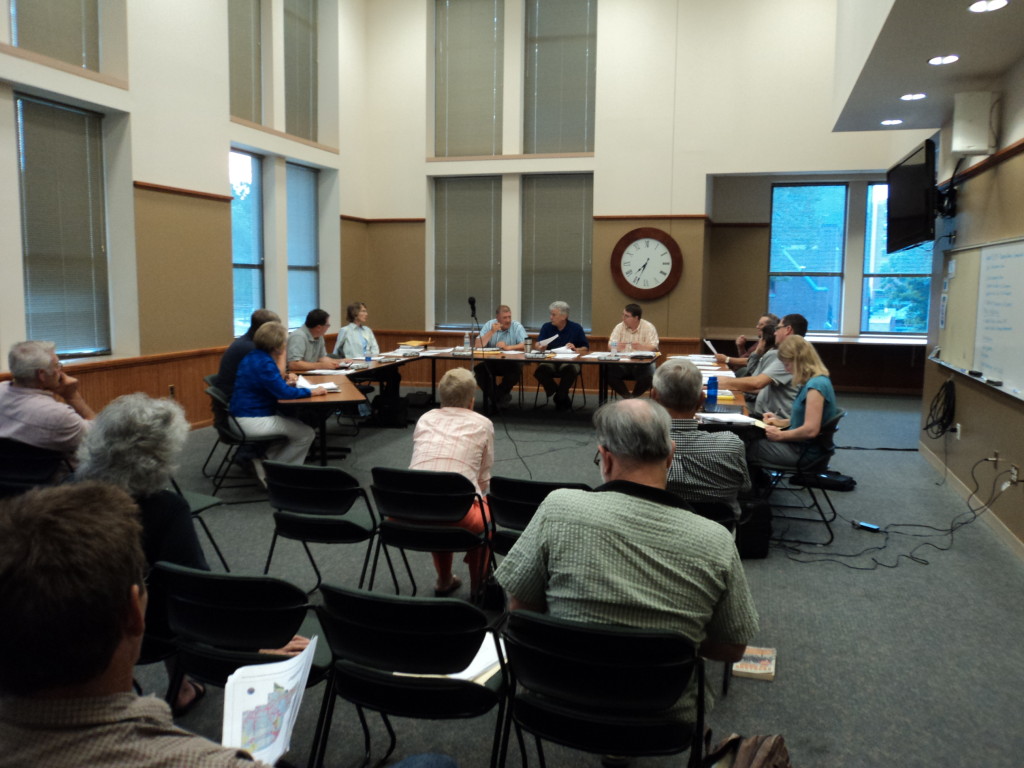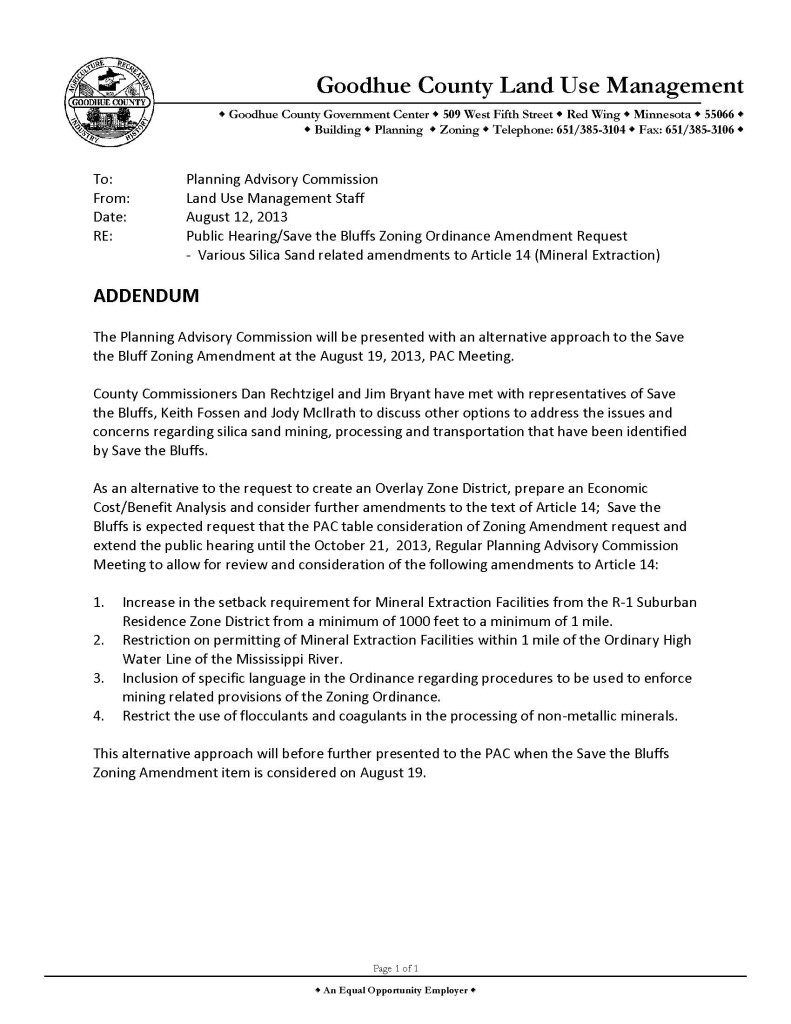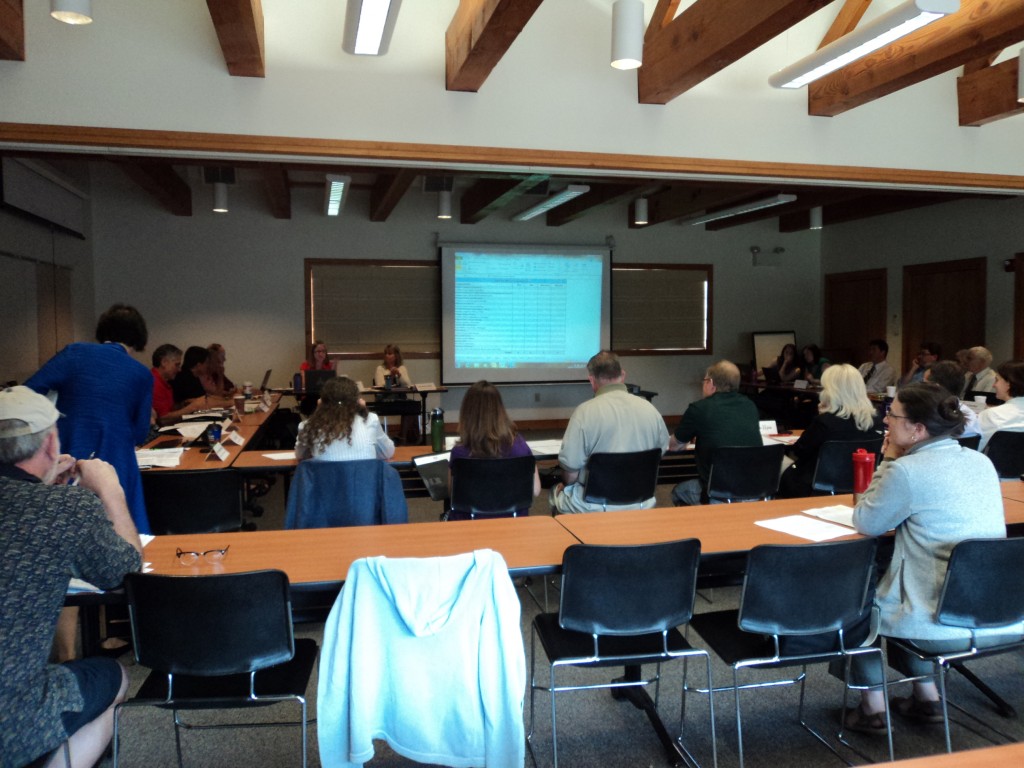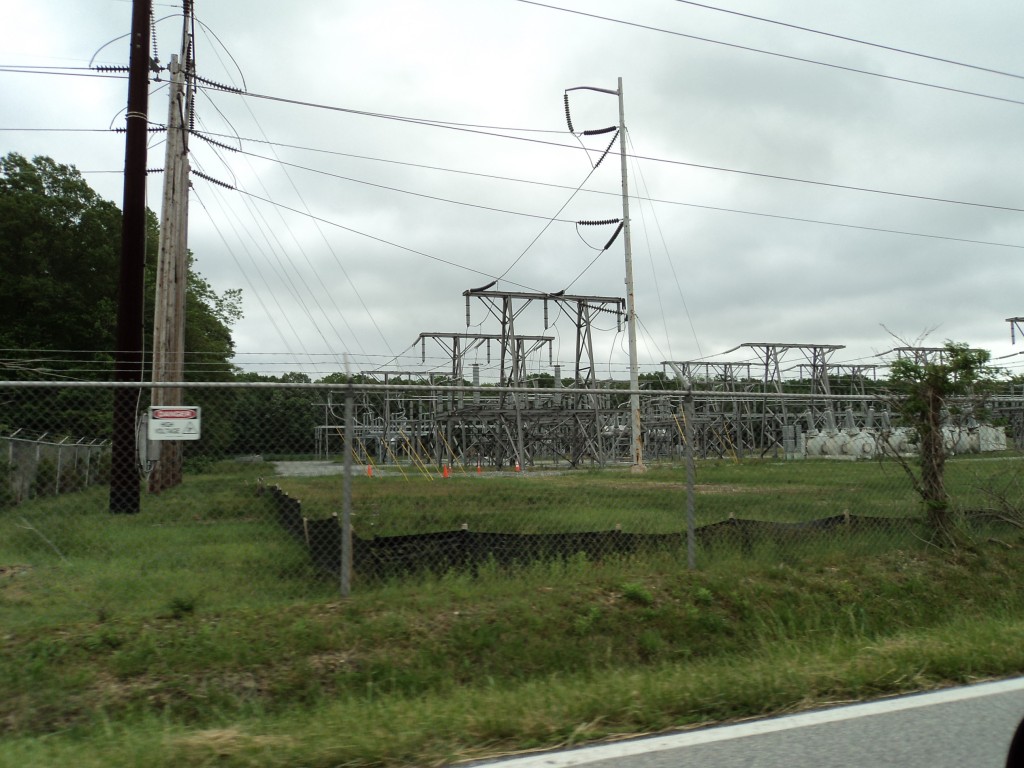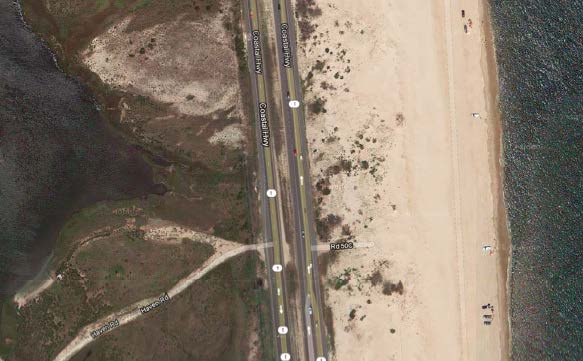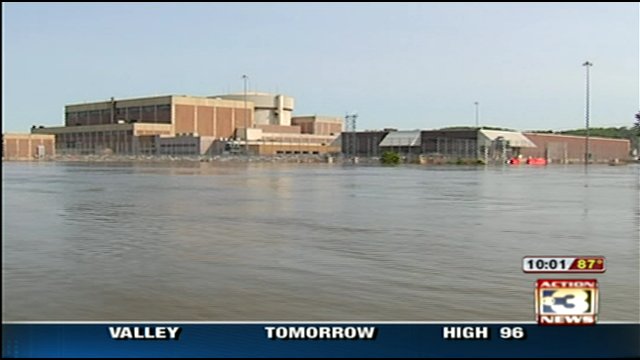Most interesting Goodhue PAC meeting
August 20th, 2013
Very interesting meeting last night, a meeting of the Planning Advisory Committee of Goodhue County. It’s unfortunate there weren’t more people there. I wasn’t going to go, but I went to support Marie McNamara’s request to the PAC to send a letter to the Environmental Quality Board, Pollution Control Agency, and Dept. of Natural Resources to appoint a Rulemaking Advisory Committee. Getting the local governments and public involved in the state process is something I’ve been on for a long time, and it needs to have a better result than the composition of the PUC’s Certificate of Need and Siting/Routing rulemaking committee which has only one member of the public, one attorney who represented a township in a transmission proceeding, two attorneys (including moi) who represent citizens groups, and 18-20 representatives of utilities.
It was a quick request:
Requests for an Advisory Committee must be made because the MPCA and DNR stated in their Notice that they didn’t anticipate having an Advisory Committee:
Minnesota Department of Natural Resources_Notice of Rulemaking
So now the next step at the County is to get Board approval and get a request out in time for the EQB’s September 18 meeting, which should not be a problem.
You can send a request too! Send a short email, with Subject line “EQB, MPCA and DNR Silica Sand Rulemaking” to:
heather.arends@state.mn.us; tom.landwehr@state.mn.us; nathan.cooley@state.mn.us; John.Stine@state.mn.us; Jeff.Smyser@state.mn.us; bob.patton@state.mn.us; kate.frantz@state.mn.us; dave.frederickson@state.mn.us
Marie McNamara has done a superb job over the five years she’s been working on wind issues. We’ve been working together for a long time now, and she’s always keeping the big picture in mind. She’s worked hard to educate regulatory bodies, from Goodhue County to the PUC, DNR, USFWS, FAA, and has done so with the utmost integrity. One of her mantra’s is “how will this affect my neighbors,” and she’s felt an obligation to keep in this fight, deal with the big policy issues and assist others in similar situations in Minnesota and across the country to participate in the process. Watching her address the PAC Committee, explaining her work on the PUC’s Rulemaking Advisory Committee, how it is the place for people to have their ideas heard, relating it to their work on the County wind ordinance, I was so gratified to see her increasing ability to independently navigate the system and encourage others to step up. She’s open and transparent in her approach and has a broad range of knowledge of process and specifics. She’s been before the PAC and County Board so many times, and has worked hard to inform the record and done a good job of it. She’s been there, done that, and is just the one to ask them to support an Advisory Committee for silica sand rulemaking.
Dan Rechtzigel and Bernie Overby were agin’ it, and Bernie was convinced that people who participate do so from one point of view, and his concern was it is only opposition to projects point of view at the table, HELLO — reality is that it’s severely weighted in favor of industry. He should go to a rulemaking committee and check it out.
I appreciated Joan Volz’ explanation that rulemaking input has to happen soon, because once it’s released, it’s pretty tough to change. In my experience, and actually, as established in the rulemaking process, the public comment period after the release of the draft is not an opportunity to do much other than generate some dead trees or use some electrons and brain cells, and that the draft is pretty much set in stone because they cannot approve a rule that is “significantly” different from the draft. That’s how it is.
Bottom line: The PAC asked staff to check it out and report to the Board, which meets the first week of September, ample time to get a request to the EQB prior to their meeting on September 18, 2013 — motion passed unanimously. I’m confident they’ll get it done.
As for the Save the Bluff’s Application, they had an “alternative approach” on the agenda based on a letter dated August 12 regarding a past meeting between the Applicants and two commissioners (click for larger version):
It’s good that there was a discussion in public about this “alternative approach” as it was a result of private negotiations between Keith Fossen and Jody McIlrath, and Dan Rechtzigel and Jim Bryant, alluded to on p. 11 of the packet in the letter above. Dan went too far, who at one point discussing these negotiations said, “on behalf of the Board…” He’s the swing vote in this situation, but he can’t speak for the board, particularly on an Application where’s there’s action pending. He should know that. The good news is that at the very beginning, Lisa Hanni provided an opening where Save the Bluffs could avoid withdrawing the original Application. They said they did not want to withdraw the application, but to focus on the 4 items, see if that can resolve the issues.
Dan Rechtzigel said that the Applicants reached out to him to talk about whether there was any possible resolution and that they came up with four areas they could talk about and come to agreement, with the acceptable items of agreement being:
This is where Dan said (rough quote), “these four areas are where we could find some common ground, on behalf of the Board…” and that these points are not intended to be final wording. In discussion of the cost-benefit analysis, Dan said, “I’m not hearing an urgent request for that.”
At one point, Bernie Overby said, “I think discussions were very productive.” Was he part of this?
There were a few comments from the public, first from a contingent from Belvidere who were very upset about not getting notice that the public hearing was cancelled. Also, after they spoke, Planning Advisory Commission Brandon Schrader, who had recused himself, tried to speak, and I had to shout out an objection, because someone who recuses himself can’t be participating, not just in the decision, but also in the discussion. That’s pretty basic procedure, but Rich Bauer, the current chair, didn’t stop him at the last PAC meeting I went to and didn’t here. No choice but to do it, and thankfully Marie knows him and had a chat about that which I hope he heard, I think he really didn’t know that wasn’t permissible. Bernie Overby didn’t understand either and started on a “free speech” rant. He needs some procedural instruction.
Belle Creek’s Township Supervisor Tom Gale was there too, and he said he didn’t receive notice and wasn’t too pleased. Bernie Overby made a remark about people showing up for the first time, and apparently he didn’t know Belle Creek township is interested, is interested in water protections, and has had a representative, usually Tom, at most of the sand related county meetings. He had a copy of the packet and wanted to know more about the “alternate approach” and what it does for Goodhue County. Belle Creek was one of the townships asked to develop a supportive resolution, as Belle Creek had requested of others during their struggle about the AWA Goodhue/New Era wind project. Belle Creek township is a farming township and they are very concerned about water, the surface water and the aquifer, and assuring safe and sufficient water for the farms in the township. Belle Creek Watershed District is one of the few, three, I think, formal Watershed Districts in the state. The Watershed District is a formal local unit of government, and should be included in the “consultation” by the state about silica sand mining Standards and Criteria, but that’s another topic… Belle Creek Township would likely be very supportive of regulations that protect the water supply.
Alan Muller brought up the point that #1 of the four points is a one mile setback from R-1 Suburban Residential, and asked what percentage of R-1 Suburban Residential land was in Goodhue County, what percentage of residents/landowners. Get out your magnifying glass and look for the tan R-1 Suburban Residential areas (click for larger map):
Ultimately, Bernie Overby made the motion to table the Save the Bluff’s request, to send it to the Mining Study Committee, to add the four items to the agenda, and the Applicants were to be directed to work with the Committee. It was passed unanimously.
There will be two public hearings on both the original Application and the 4 additional points, first before the Planning Advisory Committee and then before the County Board. These public hearings will be noticed, hopefully better than this meeting and the cancellation of the public hearing!
By the way, Bernie Overby, what’s Ryan hauling in that stainless trailer behind the shiny lime green truck with “Overby Trucking” on the door?
JCSP Big Picture – who pays? WE DO!
July 2nd, 2013
Transmission — it’s all connected. In looking at the Minnesota rulemaking, and the existing and proposed rules that utilize the word “regional,” I’m thinking about big picture stuff, the big proposals in the wings, and that Joint Coordinated System Plan (JCSP) map sure presents a big picture. For some reason, I’ve not been able to find the full JCSP report until recently:
Who cares about JCSP? Well, WE’D better care, because look who’s paying for the transmission build-out (p. 68 of Vol. 1):
Look at the numbers for Midwest ISO, a $-10,293, or for MAPP, a $12,292, that’s a COST, not a savings. MISO and MAPP get nominal production cost savings and massive load COSTS. This is not news, but is worth repeating as we discuss “regional.” And another take with the same take-away of big costs for MISO and MAPP customers, used by our good friends at AWEA to promote this transmission buildout in their flyer called “Green Power Transmission and Consumer Savings” (flyer below):
Read the whole thing:
What a deal, eh?
Look what AWEA has been advocating to make this happen:
Goodhue Wind — a project that stinks by any name…
June 20th, 2013
PUC pulls plug on Goodhue Wind project!
‘Bout time this project went down… What a thorny long drawn-out heated and circular discussion, but after a long five years, the Public Utilities Commission said no to Peter Mastic’s New Era and its request for an extension of time to get the project in service and operational. Did I mention this has been a long journey? It took five long years of persistent work on so many fronts, dogged work on the part of so many people! L-O-N-G! I first met with Goodhue Wind Truth and started representing them in late 2008, early 2009.
Just from today I have 12 pages of notes, so here’s the nutshell version, from the two page Revised Decision Options:
- After a protracted discussion, they first voted to DENY Todd Guererro’s Motion for another two weeks to prepare as he was just hired on. Nope, says the Commission, we don’t buy it, New Era f/k/a/ f/k/a has had plenty of time.
- And after an even longer more protracted and circular discussion, the Commission voted UNANIMOUSLY decision options 2 I & J:
- Then came their vote on the Extension Request as a housekeeping matter:
- And then, at the bottom of page 2, adding “August 23, 2013” as the date certain for a response:
DONE!
GOOD RIDDANCE!
Todd Guererro, representing Peter Mastic f/k/a f/k/a, did a valiant job given what he had to work with, a client who didn’t bother to comply with PUC Orders, Information Requests, and laws — he deserves battle pay for taking the hits hurled by the Commissioners, deserved, but he did the best job possible… well, except he apparently didn’t know that the Commission had made the determination that the project was a C-BED project many years ago, that it was not the Commissioner of Commerce.
I kept my trap shut, thinking “less is more.”
IT’S DONE!
IT’S REALLY DONE!
And an interesting sidebar, NSP had its crew there to monitor its interests (Verified Complaint for Declaratory Judgment, and what a delightful Complaint it is!), and I learned that my arch-nemesis Mike Krikava is a horn player, has a big band of reknown, Nova Contemporary Jazz Orchestra (not Les Brown, perhaps Minnesota’s Toshiko Akiyoshi??), and even played with Ed Berger. Mike brought it up, wondering how I knew the “real outside” Ed, but folks, it’s a small, small world… who knew?!?
And that after he ruins his reputation with his “heart-shaped” dot in his signature as noted by at least two of my GWT client’s cohorts:
Kinda skews my view, though the blustery honking of Bari fits him well. It’s sort of like Mark Dayton being a shep nut — I will have higher expectations — we shall see… but if Krikava were a trumpet player, well, that’d be another matter entirely.
In the Rochester Post Bulletin tonight:
PUC commissioner: It’s time to pull the plug on New Era project
Delaware prepares for sea level rise
May 24th, 2013
Yesterday was a meeting of the Delaware Sea Level Rise Advisory Committee at Kitts Hummock, by Dover. Their charge is broad:
“…potential solutions to reduce risk to sea level rise impacts…” but they’re missing the boat in at least one obvious area…
The reality of sea level rise is apparent every time I head up to Delaware City, because Route 9 is underwater, from 1/3 to 2/3 of the southbound lane. When we headed to Kitts Hummuck (what’s a hummuck? “It’s like a tussock, but bigger,” Alan says.) and there was water on Route 9 south of Port Penn, too. Delaware is SO flat, and Port Penn’s development has moved back from water’s edge:
In looking at the draft report, the first thing I noticed was that there was nothing about preparation about how sea level rise would affect utility infrastructure (the love of my life!). During a break, the DOT rep at the meeting let me know that they’d done a “Vulnerability Study” that addresses that, and here it is:
.. and no, there’s nothing about electrical infrastructure, ranging from generation, to transmission, to distribution. A search shows only one reference to electrical:
Data Collection
In order to conduct an in-depth vulnerability assessment, geographic datasets are necessary. Geographic datasets are a special type of dataset that contains information so that it can be placed on a map. Delaware Coastal Programs staff spent considerable time and effort compiling geographic datasets that could be utilized
with the sea level rise scenario maps to determine the location and numbers of resources at risk from sea
level rise. Datasets like roads, railways and public safety facilities were relatively easy to obtain as they are
maintained and routinely updated by a state or county agency. Many datasets were out of date or lacked
appropriate documentation as to when the data was collected or how it was collected (metadata). A few
datasets were unable to be used for this assessment due to privacy or homeland security concerns (electrical
substations for example). In many other cases, the desired data did not exist or was so out of date that it could
not be used.
Oh my… ummmmmmm… what a bunch ‘o crap! They need to look at this stuff, and for sure they have access. They are a government entity doing planning. EARTH TO MARS — all they have to do is sign a form, and if they don’t want to do that, they can look at google maps. THERE IS NO EXCUSE FOR THIS.
Why does it matter whether they consider electrical infrastructure? Well, electricity is deemed an essential service, and if it’s underwater, they’re gonna have problems, to put it mildly. Power plants are typically located on water, Indian River is a perfect example, sited on the Indian River Bay, just off the ocean, and about a foot above the water level:
What do they say about the Indian River power plant? This is it:
The Indian River power plant is the only heavy industrial facility permitted by the Coastal Zone Act in Sussex
County. This facility’s disposal area, shoreline, and intake structures are within areas that will be inundated by sea level rise, but the power plant itself is not within a potential inundation area.
Otherwise, power plants are addressed only in terms of impact of loss of rail service. Great…
Here’s a photo I took of one of the substations they’re ignoring — took this photo while flying by on Route 9, close to Kitts Hummock. I saw this substation, there’s no reason they can’t, and when this substation goes underwater, then what? A state with homes as old as ours should have an understanding of long-term planning (it looks to me that this was built in anticipation of MAPP, it’s huge and has a lot of empty positions:
The only transmission considered is disease transmission. An example of transmission facilities at issue is the one along Hwy. 1, by Indian River, pictured here where the Bay is on the west (left), the transmission line is immediately adjacent to the southbound lane of Hwy. 1, and the ocean is east of Hwy. 1:
Nuclear is not mentioned, despite the three reactor Salem and Hope Creek plant just across the Delaware Bay. With sea level rise, it will soon look like Ft. Calhoun:
Here’s what they have to say about pipelines, p. 101 of Vulnerability Assessment — they’re not concerned:
Underground Pipeline Utilities: This resource includes natural gas and petroleum pipelines. Workgroup
members also initially considered water and sewer pipelines; however, data was unavailable due to privacy and homeland security concerns. Between 4% and 6% of pipeline utilities throughout the state are within an area that could be inundated by sea level rise by the year 2100. While sections of pipeline are exposed in all three counties, the highest concentration is found in New Castle County. The results from the analysis showed that major supply lines will not be affected; however, distribution along with pipeline corrosion may become issues in the future. Due to these considerations, inundation of underground pipeline utilities is of low concern at this time.
Despite the significant omissions, look at all the Delaware organizations that supported it:
Anyway, then yesterday, they approved the recommendations, with a few minor changes. And those recommendations are not posted — the most recent minutes are from March… sigh…
So rough and quick and dirty review of what they did:
- Approved the lion’s share of the recommendations;
- Deleted #17, which was focused on financial assurance to minimize the state’s liability. GRRRRRR!
- Approved #35 which shifts the burden of notice/disclosure to a home buyer, rather than on a seller and/or realtor. This is SO WRONG!
- Sussex County rep was worthless, sat there silently except to abstain from voting. ?????
From the News Journal:
Saving Delaware’s coast from sea-level rise
Sussex declines to vote on proposed sea-level rise responses
2012 NERC Long Term Reliability Assessment
May 7th, 2013
The North American Electric Reliability Corporation (NERC) released its 2012 Long Term Reliability Assessment last November. This rates a BIG SIGH, I have yet to post it. How can that be? Well, November was a hectic time, to put it mildly, but then I look and it’s the same thing last year. Anyway, here we go!
And in case you missed it:
Now, as to some of the specifics in the 2012 Reliability Assessment. I was recently asked about “wind replacing coal” which is a popular fallacy, because it doesn’t replace coal, not physically, not electrically, not legally, no way, no how.
From the NERC 2012 Long Term Reliability Assessment, p. 103-104 (click for larger version):
And NERC Report p. 107 – Retiring coal plants are the old small ones (divide the MW by units)
When you’re hearing people crowing about less coal generation, about using less coal, and about generating less CO2, that’s all because there’s less demand, they’re not needing the old, expensive smaller coal plants to meet demand.
Another view of retirements –dispatch is on “economic” basis, meaning cheapest first. That means big coal. The old small coal plants are very costly to run and usually don’t. What this means is that they can shut down the small inefficient and uneconomic plants without suffering because they don’t need them for demand, and they’re high priced to operate and usually sit idle anyway. Now that natural gas is so cheap, it also means natural gas, although in Midwest, they don’t use gas for baseload, as they do on east coast. So the gas here is peaking power, and is usually more expensive because it’s owned by IPP and under Power Purchase Agreements for peaking (high price). Though Xcel owns its own gas now, remember it repowered a couple old coal plants, and they probably could use that more often and don’t have to pay the higher prices of peaking PPAs. See Retirements, NERC Report, p. 8 of 335:
And remember, not one Renewable Energy Standard “replaces” anything. It is a mandate to generate more electricity ON TOP OF the surplus. And the mandate is needed because there is no market. It’s adding surplus to surplus. Not one RES in the nation says “generation X MW of renewable and decrease fossil by X or X-Y or ?.” There is no replacement intended or accomplished. Further unlike solar, wind is off peak, when they’re doing their market transactions, selling all the coal they can. How much can they sell? Well, it’s not reported in the MISO section of the NERC report, which states that only internal transactions MISO are reported (again, click for larger view):
Anyway, bottom line is that reserve margins are twice what they need to be (click chart for the big picture):
